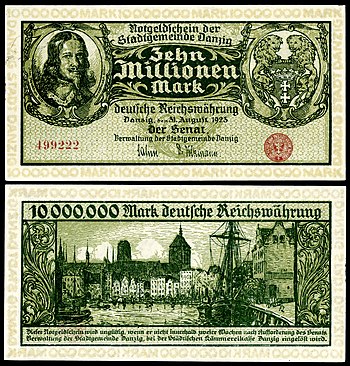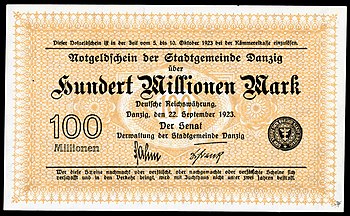Talk:Papiermark
| This article is rated Start-class on Wikipedia's content assessment scale. It is of interest to the following WikiProjects: | |||||||||||||||||||||||||||||||
| |||||||||||||||||||||||||||||||
Merge with Notgeld? --Ashmodai 22:27, 16 Jun 2005 (UTC)
So that would mean english Million = Million, and English Billion = German Milliarden! Enlil Ninlil 04:49, 24 June 2006 (UTC)
- Yes, you're right. See the reference to "long scale/short scale". I corrected the paragraph about the "present system" of naming large quantities. MikeZ 08:26, 2 August 2006 (UTC)
an error of 10 to the 9th power[edit]
I did not realize that the confusion I put in milliard and clicked on search. The first result said in French milliard means 1000. Clearly this could lead to an error of 1000 million times! If this is discused somewhere in Wikipedia, more cross references are needed. I was not aware of milliard until I read the articles and discusions about billion and the disabiguation of billion Ccpoodle 04:26, 22 April 2007 (UTC)
The title should definitely by "German papiermark"[edit]
I know that Germans like to capitalize all nouns but this is English and the names of currencies are definitely not capitalized except at the start of a sentence, e.g. U.S. dollar, British pound, Eurozone euro.
I'll change the title once I figure out how.
Are there any good pictures of the currency??
Smallbones 14:23, 9 June 2007 (UTC)
- Please note that German Rentenmark and German Reichsmark all use capitals in the article name. A general discussion of this matter some time ago lead to the use of the names without capitals in the article titles but this has since been changed unilaterally. If you move this article, please move the others to maintain consistency. Also, please note that the capitalized form must be used in text.
Dove1950 11:26, 11 June 2007 (UTC)
Fair use rationale for Image:1923-9-1-500mil.jpg[edit]

Image:1923-9-1-500mil.jpg is being used on this article. I notice the image page specifies that the image is being used under fair use but there is no explanation or rationale as to why its use in this Wikipedia article constitutes fair use. In addition to the boilerplate fair use template, you must also write out on the image description page a specific explanation or rationale for why using this image in each article is consistent with fair use.
Please go to the image description page and edit it to include a fair use rationale. Using one of the templates at Wikipedia:Fair use rationale guideline is an easy way to insure that your image is in compliance with Wikipedia policy, but remember that you must complete the template. Do not simply insert a blank template on an image page.
If there is other fair use media, consider checking that you have specified the fair use rationale on the other images used on this page. Note that any fair use images lacking such an explanation can be deleted one week after being tagged, as described on criteria for speedy deletion. If you have any questions please ask them at the Media copyright questions page. Thank you.
BetacommandBot (talk) 18:46, 13 February 2008 (UTC)
200, 2000, 2E8 and 2E9 Papiermark[edit]
Were there any notes in the denominations 200, 2000, 2E8 and 2E9 Papiermark printed? --88.78.238.23 (talk) 16:33, 30 March 2008 (UTC)
Government printing banknotes? - Contradictions[edit]
How could the government print banknotes to pay it's war debt?
- They were supposed to pay in gold or in a currency on the gold standard which the papiermark was not.
- The Reichsbank who held the power to print money was a privately owned central bank.
This does not add up. —Preceding unsigned comment added by 60.226.179.194 (talk) 12:32, 21 June 2010 (UTC)
The war debts were bonds issued mainly to German people during the war. The gold was required for reparations, not war debt. The Reichsbank power to print money was non-exclusive. The Treasury Notes, loan fund notes and a few privileged banks could also issue paper currency. Private speculators could short-sell the currency too. 86.214.202.188 (talk) 00:55, 15 November 2011 (UTC)
long/short scale[edit]
Could you all please stop mixing up long and short scale numbers? And keep in mind that the banknotes during the hyperinflation do not show lots of zeroes, but indeed the words "Milliarde" and "Billion"? It is all explained in the article, so please keep it consistent - as well internally as with what's actually printed on the banknotes.
There was a time every single number was explained. Why was it deleted?
The confusion won't be less if the article uses exclusively the american short scale, and now someone who knows about long and short scale misreads american trillions as german ones, e.g. then he reads there was a 100 trillion Mark banknote and interprets it as "100 Trillionen". — Preceding unsigned comment added by Caballito (talk • contribs) 16:10, 3 December 2011 (UTC)
Wheelbarrows of cash[edit]
A fellow who lived through the German hyperinflation told me the wheelbarrows of cash is a fallacy. Old cash was sold by weight for fuel, but no one would bother to count a wheelbarrow of cash, much less accept it. If a merchant accepted wheelbarrows of cash, what would he do with tons of cash at the end of the day? Randall Bart Talk 03:02, 23 April 2015 (UTC)
Inconsistent scale[edit]
The article uses the long scale in the section "Weimar Republic" but the short scale in the section "Danzig". It should be one or the other, not both. JIP | Talk 09:23, 9 August 2019 (UTC)
File:DAN-24-Danzig-1MIL Mark (1923).jpg scheduled for POTD[edit]
Hello! This is to let editors know that the featured picture File:DAN-24-Danzig-1MIL Mark (1923).jpg, which is used in this article, has been selected as the English Wikipedia's picture of the day (POTD) for August 13, 2020. A preview of the POTD is displayed below and can be edited at Template:POTD/2020-08-13. Any potential improvements or maintenance that could benefit the quality of this article should be made before its scheduled appearance on the Main Page. If you have any concerns, please place a message at Wikipedia talk:Picture of the day. Thank you! Cwmhiraeth (talk) 11:23, 29 July 2020 (UTC)

|
The Papiermark is the name given to the German currency from 4 August 1914, when the link between the Goldmark and gold was abandoned. In particular, the name is used for the banknotes issued during the period of hyperinflation in Germany in 1922 and especially 1923. During this period, the Papiermark was also issued by the Free City of Danzig. The last of five series of the Danzig mark was the 1923 inflation issue, which consisted of denominations of 1 million to 10 billion issued from August to October 1923. The Danzig mark was replaced on 22 October 1923 by the Danzig gulden. This one-million-mark banknote, issued on 8 August 1923, features a portrait of Danzig-born painter and printmaker Daniel Chodowiecki on the obverse and is in the National Numismatic Collection of the Smithsonian Institution's National Museum of American History. Other denominations:Banknote design credit: Danzig Central Finance Department; photographed by Andrew Shiva
Recently featured:
|

|
The Papiermark is the name given to the German currency from 4 August 1914, when the link between the Goldmark and gold was abandoned. In particular, the name is used for the banknotes issued during the period of hyperinflation in Germany in 1922 and especially 1923. During this period, the Papiermark was also issued by the Free City of Danzig. The last of five series of the Danzig mark was the 1923 inflation issue, which consisted of denominations of 1 million to 10 billion issued from August to October 1923. The Danzig mark was replaced on 22 October 1923 by the Danzig gulden. This ten-million-mark banknote, issued on 31 August 1923, features a portrait of Danzig-born astronomer Johannes Hevelius on the obverse and is in the National Numismatic Collection of the Smithsonian Institution's National Museum of American History. Other denominations:Banknote design credit: Danzig Central Finance Department; photographed by Andrew Shiva
Recently featured:
|

|
The Papiermark is the name given to the German currency from 4 August 1914, when the link between the Goldmark and gold was abandoned. In particular, the name is used for the banknotes issued during the period of hyperinflation in Germany in 1922 and especially 1923. During this period, the Papiermark was also issued by the Free City of Danzig. The last of five series of the Danzig mark was the 1923 inflation issue, which consisted of denominations of 1 million to 10 billion issued from August to October 1923. The Danzig mark was replaced on 22 October 1923 by the Danzig gulden. This one-hundred-million-mark banknote, issued on 22 September 1923, is in the National Numismatic Collection of the Smithsonian Institution's National Museum of American History. Other denominations:Banknote design credit: Danzig Central Finance Department; photographed by Andrew Shiva
Recently featured:
|

|
The Papiermark is the name given to the German currency from 4 August 1914, when the link between the Goldmark and gold was abandoned. In particular, the name is used for the banknotes issued during the period of hyperinflation in Germany in 1922 and especially 1923. During this period, the Papiermark was also issued by the Free City of Danzig. The last of five series of the Danzig mark was the 1923 inflation issue, which consisted of denominations of 1 million to 10 billion issued from August to October 1923. The Danzig mark was replaced on 22 October 1923 by the Danzig gulden. This five-hundred-million-mark banknote, issued on 26 September 1923, features a portrait of Danzig-born philosopher Arthur Schopenhauer on the obverse and is in the National Numismatic Collection of the Smithsonian Institution's National Museum of American History. Other denominations:Banknote design credit: Danzig Central Finance Department; photographed by Andrew Shiva
Recently featured:
|

|
The Papiermark is the name given to the German currency from 4 August 1914, when the link between the Goldmark and gold was abandoned. In particular, the name is used for the banknotes issued during the period of hyperinflation in Germany in 1922 and especially 1923. During this period, the Papiermark was also issued by the Free City of Danzig. The last of five series of the Danzig mark was the 1923 inflation issue, which consisted of denominations of 1 million to 10 billion issued from August to October 1923. The Danzig mark was replaced on 22 October 1923 by the Danzig gulden. This five-billion-mark banknote, issued on 11 October 1923, is in the National Numismatic Collection of the Smithsonian Institution's National Museum of American History. Other denominations:Banknote design credit: Danzig Central Finance Department; photographed by Andrew Shiva
Recently featured:
|

|
The Papiermark is the name given to the German currency from 4 August 1914, when the link between the Goldmark and gold was abandoned. In particular, the name is used for the banknotes issued during the period of hyperinflation in Germany in 1922 and especially 1923. During this period, the Papiermark was also issued by the Free City of Danzig. The last of five series of the Danzig mark was the 1923 inflation issue, which consisted of denominations of 1 million to 10 billion issued from August to October 1923. The Danzig mark was replaced on 22 October 1923 by the Danzig gulden. This ten-billion-mark banknote, issued on 11 October 1923, is in the National Numismatic Collection of the Smithsonian Institution's National Museum of American History. Other denominations:Banknote design credit: Danzig Central Finance Department; photographed by Andrew Shiva
Recently featured:
|
sensless text[edit]
This sentence " The victor nations in World War I decided to assess Germany for their costs of conducting the war against Germany. " makes no sense at all. A false flag attack against the own people inside the own country? never heard about. 217.79.194.135 (talk) — Preceding undated comment added 12:27, 17 March 2022 (UTC)


